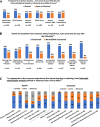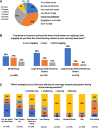A hierarchy of needs for remote undergraduate medical education: lessons from the medical student experience
- PMID: 35655160
- PMCID: PMC9161626
- DOI: 10.1186/s12909-022-03479-4
A hierarchy of needs for remote undergraduate medical education: lessons from the medical student experience
Abstract
Purpose: The disruption of undergraduate medical education (UME) by the COVID-19 pandemic has sparked rapid, real-time adjustments by medical educators and students. While much is known about online teaching in general, little guidance is available to medical educators on how to adapt courses not originally designed for the online environment. To guide our faculty in this transition we conducted a needs assessment of students enrolled in virtual courses across all 4 years of UME training.
Methods: Using a mixed-methods approach, we conducted a single-institution virtual learning needs assessment in May and June of 2020. We developed and disseminated a survey to assess student experiences with virtual learning. We conducted quantitative and qualitative analysis of responses (n = 255 or 39%) to identify emergent themes.
Results: We identified six interdependent themes that need to be met for medical students to fully reach their learning potential: access to stable internet and quiet study spaces, flexible course design with asynchronous, self-paced components, clear expectations for engagement with content and each other, a sense of connectedness with faculty and peers, synchronous classes that maximize interactivity, and assessments that foster a sense of learning over performance. Interpersonal relationships with faculty and peers affected students' sense of learning more than any other factor.
Conclusions: Based on our findings we propose a hierarchy of needs for virtual learning that provides guidance on adapting existing medical school courses to the remote setting and overcoming common challenges. We highlight opportunities for how virtual elements may enrich in-person courses going forward, including in the clinical setting. Although the solutions required to meet the threshold of need at each level may differ based on the context, attending to these same fundamental needs can be extrapolated and applied to learners across a range of environments beyond the virtual.
Keywords: Flipped classroom; Online teaching; Remote learning; Telehealth; Undergraduate medical education.
© 2022. The Author(s).
Conflict of interest statement
The authors declare that they have no competing interests.
Figures



Similar articles
-
Student and educator experiences of maternal-child simulation-based learning: a systematic review of qualitative evidence protocol.JBI Database System Rev Implement Rep. 2015 Jan;13(1):14-26. doi: 10.11124/jbisrir-2015-1694. JBI Database System Rev Implement Rep. 2015. PMID: 26447004
-
A virtual emergency: learning lessons from remote medical student education during the COVID-19 pandemic.Emerg Radiol. 2021 Jun;28(3):445-452. doi: 10.1007/s10140-020-01874-2. Epub 2021 Jan 8. Emerg Radiol. 2021. PMID: 33420528 Free PMC article.
-
Perceptions of medical students towards online teaching during the COVID-19 pandemic: a national cross-sectional survey of 2721 UK medical students.BMJ Open. 2020 Nov 5;10(11):e042378. doi: 10.1136/bmjopen-2020-042378. BMJ Open. 2020. PMID: 33154063 Free PMC article.
-
Online learning developments in undergraduate medical education in response to the COVID-19 pandemic: A BEME systematic review: BEME Guide No. 69.Med Teach. 2022 Feb;44(2):109-129. doi: 10.1080/0142159X.2021.1992373. Epub 2021 Oct 28. Med Teach. 2022. PMID: 34709949
-
A virtual COVID-19 ophthalmology rotation.Surv Ophthalmol. 2021 Mar-Apr;66(2):354-361. doi: 10.1016/j.survophthal.2020.10.001. Epub 2020 Oct 12. Surv Ophthalmol. 2021. PMID: 33058927 Free PMC article. Review.
Cited by
-
Rapid Transition to Virtual Learning in Postgraduate Medical Education during the COVID-19 Pandemic in Tanzania: A Qualitative Study.Ann Afr Med. 2024 Nov 8;24(1):146-51. doi: 10.4103/aam.aam_41_24. Online ahead of print. Ann Afr Med. 2024. PMID: 39513432 Free PMC article.
-
Examining Physical Therapy Students' Subjective Mastery of Simulated Clinical Practice Using Smart Glasses to Share Teacher's Visual Field Information.Juntendo Med J. 2025 Mar 12;71(2):106-114. doi: 10.14789/ejmj.JMJ24-0033-OA. eCollection 2025. Juntendo Med J. 2025. PMID: 40395915 Free PMC article.
References
MeSH terms
LinkOut - more resources
Full Text Sources
Medical
Miscellaneous

